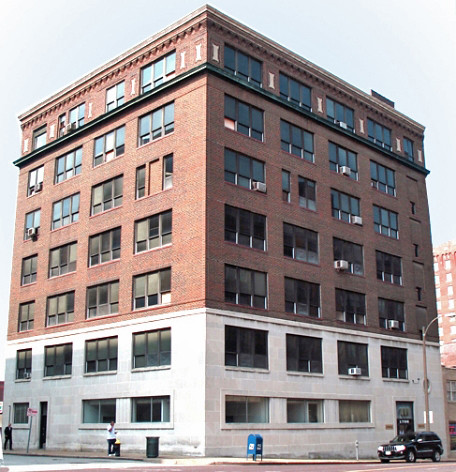
In late may I posted about how the Midwood Hotel in Overland would be demolished if a proposed roundabout proposed by St. Louis County is constructed at the intersection of Midland Blvd., Woodson Rd. & E. Milton Ave. The aerial above is only a conceptual diagram of what a roundabout could look like at this intersection. I have seen no real drawings. The circle is about the size of the pavement at one of the larger roundabouts in the area at Highway 40/64 and Spoede Road in St. Louis County. It is about 180 feet in diameter. The roundabout in Forest Park at the terminus of Hampton is about 130 feet across. More space of course would be needed for sidewalks at this location in downtown Overland.
The point of this diagram is that it is very likely that the right-of-way expansion needed for the proposed roundabout would likely only take a small portion of the Midwood Hotel, which I believe may be the tallest building in Overland (except for maybe some church steeples). Why does this matter you may ask? If they need the property, the building gets demolished, right? This has not always been the case, and in fact was once the opposite of the norm.

This photo from the book This is Our St. Louis shows the widening of Olive Street in the late 1920's, one of many public projects funded by the $87 million bond issue passed by voters in 1923. While some small buildings were demolished, including the entire block across from the Central Library to make way for the Memorial Plaza, most substantial buildings from Tucker to Grand on the south side of Olive were simply shortened and new facades installed at the front of the structure.

The Henschel Hat Building at 17th, built in 1918 is an example of one a shortened building along Olive Street. The odd width of masonry at the 17th Street elevation at the corner was the result of the new facade location not matching the original structural bay dimension.

With the darker brick color and smaller triple non-arched windows the 1920's facade of this building at 19th & Olive is a bit more obvious as not original to the building.

Further west near Compton, the Parrish Laundry Company constructed a highly ornamented terra cotta facade by architect William Levy to unify their original building, opened in 1891 (which was cut back) with an addition to the east in 1926.
Less than 30 years after the widening of Olive Street, St. Louis would squander it's boulevard dimensions when leaders decided upon wholesale destruction of the Mill Creek Valley area south of the street between 20th Street and Grand. Most of the buildings altered during the widening of Olive Street were demolished and replaced with uses facing inward on super-blocks or simply nothing at all.


54 years after the clearance began in 1959, large swaths of the south side of this 1.36 mile stretch of Olive Street sit vacant and less than a dozen buildings actually front on the right-of-way.

This three story building at 904-908 S. 4th Street is another example of a building that survived an adjacent public infrastructure project. In this case, the right-of-way to construct the approach ramp to the Municipal Bridge (renamed the MacArthur Bridge in 1942), which was built between 1909 an 1917 literally took a slice of the south bay of the building. The building, which is located in the South Fourth Street Commercial Historic District had been constructed in 1883 by the Eberle & Keys Undertaking Company. When the bridge came through, instead of demolishing the entire building, or even the entire south bay of the building, the south bay was simply shortened and a new south masonry wall built.

A view of the corner where the building was cut back. The bridge deck above is only about 5 feet from the building.

The re-built south wall viewed from under the bridge.

This 1909 Sanborn map shows the block of 4th Street between Lombard and Chouteau fully intact prior to construction of the Municipal Bridge. 904-908 S. 4th is the third building south of Lombard.

This 1950 Sanborn shows the 904-908 S. 4th Street building with its narrowed south bay.

The interior of the narrowed south bay of the building is narrow (about 12 feet), but still very usable for a commercial tenant looking for a smaller space. The building was fully renovated in 2010 using Missouri and Federal Historic Tax Credits to be leased for retail and office uses. Instead of total demolition, the same type of treatment of the right-of-way expansion could be implemented at the Midwood Hotel if the roundabout moves forward.

No comments:
Post a Comment